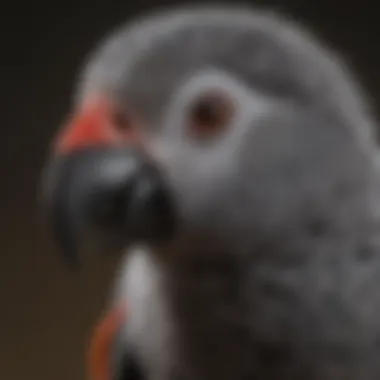Understanding Timneh African Grey: A Comprehensive Guide


Intro
The Timneh African Grey parrot stands out in the group of African Grey parrots. Known for their intelligence and unique personality, they require specific care and understanding. This article will explore the essential aspects of owning a Timneh African Grey, including their behavior, care requirements, training, health needs, and suitable activities.
Understanding Your Pet
Pet Behavior Basics
Understanding the behavior of the Timneh African Grey is crucial. They are highly intelligent birds, capable of learning and mimicking sounds. Their social nature means they thrive on interaction with both humans and other birds. Owners should expect a range of behaviors, from playful antics to periods of quiet reflection. Recognizing these behaviors will help create a nurturing environment.
Common Breed Characteristics
The Timneh African Grey has distinctive features. They have a darker plumage, with shades of grey and a characteristic maroon tail. This unique coloration differentiates them from their larger cousin, the Congo African Grey. Understanding these traits not only enhances ownership experience but also aids in health monitoring.
Species-Specific Needs
Timneh African Greys have specific needs that differ from other pets. They require a spacious cage and plenty of mental stimulation. Their diet should consist of high-quality pellets, fresh fruits, and vegetables. Understanding the unique requirements of this species ensures a happy and healthy life for the bird.
Pet Care and Maintenance
Feeding Guidelines
Feeding a Timneh African Grey involves more than just seed. A balanced diet is essential. Consider incorporating:
- High-quality pellets specially designed for parrots.
- Fresh fruits like apples, bananas, and berries.
- Vegetables, including leafy greens and bell peppers. This variety ensures they receive the necessary nutrients.
Grooming Essentials
Regular grooming is essential to keep a Timneh African Grey in good shape. This includes clipping their nails and ensuring their feathers are healthy. A regular schedule helps in building trust with the bird while keeping it comfortable and clean.
Hygiene Practices
Maintaining a clean living space is critical. Regular cage cleaning is necessary to prevent the buildup of waste and bacteria. Use safe cleaning solutions to avoid harmful chemicals that can affect the bird's health.
Training and Development
Basic Commands and Skills
Training a Timneh African Grey can be rewarding. Start with basic commands like “step up” or “stay.” Positive reinforcement techniques, such as treats, work well to encourage desired behaviors. Consistency is key in this process.
Behavioral Training Techniques
Using behavioral training techniques can help shape a Timneh's actions effectively. Techniques such as clicker training can be particularly useful. This method helps in building a bond between the owner and the pet while teaching commands.
Addressing Common Behavior Issues
Common behaviors such as biting or screaming can be addressed with patience. Identify the triggers for these behaviors to work on solutions. Understanding the motivation behind certain actions can lead to effective training strategies.
Health and Wellness
Routine Vet Check-ups
Regular veterinary visits are crucial. These check-ups can help identify potential health issues before they become serious. Establishing a good relationship with an avian veterinarian is essential for optimal health.
Vaccination Needs
Timneh African Greys may require vaccinations to prevent diseases. Consult with a vet to create a vaccination schedule tailored to your bird’s needs. Staying informed about potential health risks is key to prevention.
Recognizing Signs of Illness
Owners must be vigilant about health signs. Changes in behavior, appetite, or grooming can indicate illness. Early intervention can make a significant difference in treatment outcomes.
Enrichment and Activities


Indoor vs.
Outdoor Activities
Both indoor and outdoor enrichment are important. Indoor setups should include climbing structures and toys to prevent boredom. Outdoor activities allow for new environments and stimulation, but safety precautions are necessary.
Interactive Toys and Games
Investing in interactive toys is essential for mental stimulation. Puzzle feeders or toys that require problem-solving can keep a Timneh engaged. Rotate toys regularly to maintain their interest.
Socialization Opportunities
Timneh African Greys thrive on social interaction. Schedule regular playtime outside the cage and introduce them to various environments. This will help form a strong bond and keep them well-adjusted.
Understanding the needs of a Timneh African Grey goes beyond basic care. It is about creating a nurturing and enriching environment that fosters health and happiness.
This guide aims to provide pet owners and enthusiasts with valuable insights into caring for the Timneh African Grey. Educating oneself is the first step to ensuring responsible ownership and well-being for these amazing birds.
Prelims to Timneh African Grey
The Timneh African Grey is more than just a bird; it represents a unique aspect of avian diversity. Understanding this species is crucial for potential owners who seek a fulfilling companionship with these intelligent parrots. This section focuses on what makes the Timneh African Grey distinct and worth considering for ownership.
Overview of the Species
The Timneh African Grey is a sub-species of the African Grey parrot. It is smaller in size compared to its counterpart, the Congo African Grey. While both share a reputation for high intelligence, the Timneh's distinct characteristic includes its darker plumage and unique color transitions. This bird can be characterized by its mostly grey body with a lighter, brick-red tail. Its personality is often described as playful and curious, making it engaging for any pet owner.
In terms of vocal capability, Timneh African Greys are known to develop an extensive vocabulary, showing understanding and context. These traits make them not just companions, but learners who require mental stimulation.
Origins and Habitat
The Timneh African Grey is native to the forests and savannas of West Africa, particularly found in countries such as Guinea and the Ivory Coast. These environments are rich in biodiversity, providing natural habitats where these birds thrive. They prefer tropical and subtropical forests, often seen in small flocks. Understanding their natural habitat is important for owners, as it influences their care requirements.
In the wild, Timneh African Greys feed on seeds, nuts, and fruits, which reflects their needs in captivity. Mimicking this diet is essential to ensure their health and longevity. In breeding settings, many attempts to recreate their native habitat have been made, and successful care begins with this understanding. Therefore, the insights into their origins and habitats serve as a foundation for proper ownership, emphasizing the care and considerations needed for their welfare.
Physical Characteristics
The physical characteristics of the Timneh African Grey parrot are vital for understanding their identity and care needs. Knowledge of these traits assists potential owners in selecting healthy individuals, while also informing them about the specific care requirements the species demands. Each characteristic carries significant implications for the bird's health, behavior, and overall quality of life. By comprehensively examining these traits, we ensure that we can foster not just a pet-owner relationship but also a deep understanding of these intelligent birds.
Size and Weight
The Timneh African Grey is a medium-sized parrot. Typically, their length ranges from 10 to 13 inches. In terms of weight, adults usually weigh between 225 to 400 grams. This size is considerably smaller than that of the Congo African Grey, the more common relative of the Timneh. The compact size of the Timneh makes it suitable for various living conditions, including small apartments. Proper awareness of their size will help owners provide appropriate housing arrangements and avoid stress on the bird due to confinement or lack of space.
Coloration and Markings
The coloration of the Timneh African Grey is distinct and serves as an essential aspect of its physical identity. Their plumage is characterized by a predominantly dark gray body, complemented by a red tail and a unique maroon hue at the feathers’ edges. The head is rounded and can display a subtle variation in shades of gray, which intensifies the species’ charm. Understanding these markings not only aids in identifying the bird but also in recognizing potential signs of stress or illness through changes in color or condition of the feathers.
Distinguishing Features from Other African Greys
The Timneh African Grey possesses several distinguishing features that set it apart from its close relatives. Firstly, the beak of the Timneh is notably darker and has more of a hooked appearance compared to the Congo African Grey. Additionally, the overall size is smaller, making it less imposing. Their red tails are another characteristic that can quickly identify them, especially when in flight. Being aware of these differences allows prospective owners to appreciate the unique qualities of the Timneh African Grey and aids in proper identification if they are considering adding this specific species to their family.
Key Point: Recognizing the physical characteristics of the Timneh African Grey not only enhances understanding but also promotes better care and management of these exceptional birds.
Behavioral Traits
Understanding the behavioral traits of the Timneh African Grey is crucial for providing optimal care and companionship. These parrots are renowned for their intelligence and social nature, making it imperative for pet owners to be attuned to their unique needs. Recognizing and addressing their behavioral traits can foster a healthy, enriching environment that enhances their well-being.
Social Interaction
Timneh African Greys thrive on social interaction. They are naturally gregarious and often form close bonds with their human companions. To support their social needs, consider the following aspects:
- Daily Interaction: Timnehs require regular engagement with their owners. This can be achieved through playtime, training, and simple conversation.
- Other Pets: These birds often get along well with other pets but supervision is necessary to ensure safety.
- Group Activities: Including your Timneh in family activities can help fulfill their social needs and strengthen the bond.
Enabling social interaction not only enhances their happiness but also helps mitigate behavioral issues, such as excessive squawking or destructive chewing.
Vocalization Patterns


Vocalization is a hallmark of the Timneh African Grey's behavior. Their ability to mimic human speech and sounds adds a distinct dynamic to their personality. Important points to note include:
- Communication Signals: Parrots vocalize for various reasons, including seeking attention, expressing discomfort, or even as a form of greeting.
- Speech Recognition: Regular exposure to clear, consistent phrases can improve their ability to mimic speech.
- Volume Control: Owners should encourage soft vocalizations, promoting a calm environment. Loud vocalizations might become a nuisance if left unchecked.
Their vocal abilities require regular interaction and positive reinforcement. This process enhances their engagement and helps develop a stronger bond between bird and owner.
Intelligence and Problem-Solving
Recognized for their high intelligence, Timneh African Greys exhibit remarkable problem-solving skills. They can quickly learn new tasks and routines, making mental stimulation an essential part of their care. Consider the following:
- Puzzle Toys: Providing interactive toys can stimulate their minds and keep them entertained.
- Training Sessions: Regular training improves their cognitive skills while reinforcing your bond. Techniques like target training can be particularly effective.
- Environment Enrichment: A stimulating environment filled with varied experiences can prevent boredom and reduce undesirable behaviors.
Their impressive intelligence calls for ongoing mental challenges. Engaging with them mentally can lead to significant behavioral improvements, nurturing an enjoyable companionship.
Understanding these behavioral traits is key to ensuring a fulfilling and enriching life for your Timneh African Grey. By focusing on their social needs, communication skills, and intelligence, owners can create a harmonious living environment.
Care Requirements
Caring for a Timneh African Grey is a significant responsibility. It's essential to understand their specific needs to maintain their health and happiness. The proper care enhances their quality of life and promotes strong bonds between pet and owner. An informed approach ensures the bird thrives in captivity.
Diet and Nutrition
A balanced diet is crucial for Timneh African Grey's well-being. In the wild, they consume a varied diet, primarily consisting of seeds, nuts, fruits, and vegetables. For those in captivity, a similar balanced diet is necessary.
- Pelleted Diet: High-quality pelleted food forms the foundation of their nutrition. These pellets are designed to meet the nutritional requirements of parrots.
- Fresh Vegetables: Leafy greens like kale and collard greens should form a substantial part of their diet. Other vegetables, such as carrots and bell peppers, also provide essential vitamins and minerals.
- Fruits: Fruits should only be offered in moderation due to high sugar content. Safe options include apples, berries, and bananas.
- Nuts: Offer nuts as treats. They are high in fats and should be given sparingly.
Offering a variety of foods not only supports health but also keeps the Timneh mentally stimulated. Always avoid avocado, chocolate, and caffeine, as these items are toxic to birds.
Housing and Environment
Creating an appropriate living environment is essential to their physical and mental health. The cage should be large enough for the parrot to move around freely, with dimensions at least 24 inches long by 24 inches wide. Additionally, the cage should have:
- Perches: Vary the diameter of perches to exercise their feet. Natural wood perches are preferable over plastic ones.
- Toys: Provide a range of toys to encourage play and exploration. Chewing is a natural behavior for parrots and can prevent boredom.
- Safety: Ensure that the habitat is free from toxic materials and hazardous objects.
- Cleanliness: Regular cleaning of the cage and toys is important to prevent the buildup of bacteria and diseases.
Timneh African Grey needs at least a few hours of time outside the cage daily. Supervised interaction promotes socialization and enriches their environment.
Regular Health Check-Ups
Consistent health check-ups are important in maintaining the well-being of Timneh African Grey. These annual visits to an avian veterinarian help identify any potential health issues early.
- Importance of Regular Check-Ups: Routine check-ups can prevent minor issues from becoming serious conditions that affect the bird's health.
- Vaccinations and Treatments: Consult your vet about necessary vaccinations and preventive care.
- Signs of Health Issues: Be aware of any changes in behavior, such as reduced appetite or feather plucking. These can be indicators of health problems and should be examined by a professional.
Training and Socialization
Training and socialization are critical components in ensuring a happy and healthy life for the Timneh African Grey parrot. These intelligent birds thrive in environments that challenge their mental capabilities while also fostering social bonds with their owners. Understanding how to train and socialize your Timneh is essential not only for their well-being but also for creating a harmonious relationship between the bird and its human companions.
Essential Training Techniques
Effective training can significantly enhance the bond between the Timneh African Grey and its owner. Methods that focus on positive reinforcement tend to yield the best results. These techniques are based on rewarding desired behaviors rather than punishing unwanted actions. Common training tactics include:
- Target Training: Using a stick or target helps direct the bird's actions and can facilitate larger training goals.
- Step-Up Command: Teaching the bird to step onto your hand or a perch on command is a foundational skill for any parrot owner.
- Trick Training: Teaching tricks, like spinning or waving, can provide mental stimulation and entertainment while reinforcing the bond between bird and owner.
To achieve effective training, consistency is key. Using a calm tone and being patient during learning sessions is crucial. Training should be brief but frequent, as Timneh African Greys have relatively short attention spans. Incorporating play into training can also maintain their interest and eagerness to learn.
Creating a Stimulating Environment
A stimulating environment is pivotal for the mental health and social development of the Timneh African Grey. These parrots require ample mental and physical stimulation to thrive. Here are some considerations for providing a suitable environment:
- Toys: Offer various toys that support chewing, foraging, and problem-solving. Rotate them regularly to prevent boredom.
- Social Interaction: Spend quality time with your Timneh. They are social creatures and benefit from interactions with their owners.
- Safe Space: Provide a safe play area outside the cage where they can explore and engage in natural behaviors.
Incorporating these elements will enhance the bird’s quality of life, allowing it to display natural behaviors and stay emotionally healthy.
Positive Reinforcement Strategies
Positive reinforcement is an effective strategy that can reinforce good behavior in Timneh African Greys. This approach helps to establish trust and a loving relationship between the bird and its owner. Some methods include:


- Treats: Use your bird's favorite treats for rewarding good behavior. An example might be small pieces of fruit or nut.
- Verbal Praise: Simple phrases like “good bird” can be highly motivating for your Timneh. Parrots enjoy positive attention.
- Clicker Training: A clicker can be a valuable tool for precisely marking the desired behavior, effectively bridging the gap between action and reward.
In essence, embracing positive reinforcement creates an encouraging environment. It fosters a sense of security and motivation for your Timneh African Grey to learn and grow.
“Successful training is not just about commands but about building a relationship based on trust and respect.”
These elements collectively contribute to a fulfilling life for the Timneh African Grey, ensuring that it remains a cherished member of your family.
Health Concerns
Understanding the health concerns associated with the Timneh African Grey is pivotal for every owner and enthusiast. These birds are beloved companions known for their intelligence and social capabilities. However, like all pets, they are susceptible to various health issues that can impact their quality of life. It is crucial to be aware of these health concerns to ensure timely interventions and preventive care.
Common Health Issues
Timneh African Greys are prone to several common health issues that can arise from various factors, including diet, environment, and genetic predispositions. Some notable health concerns include:
- Obesity: Many pet owners underestimate the importance of a balanced diet. Overfeeding and lack of exercise can lead to obesity, which increases the risk of heart disease and other systemic issues.
- Feather Plucking: Stress or boredom can result in feather plucking, leading to skin infections and further psychological issues.
- Psittacosis: This is a bacterial infection that can affect both birds and humans. Symptoms in birds may include respiratory issues and lethargy.
- Proventricular Dilatation Disease (PDD): This is a severe disease affecting the digestive system and can cause weight loss, vomiting, and other digestive problems.
Being knowledgeable about these issues can help in preventing potential health crises and ensuring the longevity of your pet.
Preventive Measures
Prevention is always better than cure, especially in the case of pet health. There are several measures that owners can take to promote the well-being of their Timneh African Grey:
- Balanced Diet: Providing high-quality pellets combined with fresh fruits and vegetables is essential. Avoid high-fat and high-sugar products that can lead to obesity.
- Regular Exercise: Letting your bird out of its cage for daily exercise helps maintain physical health. Engaging toys can prevent boredom-related behaviors like feather plucking.
- Veterinary Check-Ups: Regular visits to an avian vet for health check-ups can catch potential issues early. Vaccinations and health screenings are important for long-term well-being.
- Stress Reduction: Maintaining a calm environment helps in reducing stress, which can trigger various health issues. Establishing a routine can also provide comfort for the bird.
Implementing these preventive strategies can significantly decrease the risk of health problems and enhance the quality of life for your Timneh African Grey.
Signs of Illness to Observe
Recognizing signs of illness in your Timneh African Grey can be the difference between quick treatment and serious health complications. Owners should stay vigilant for the following signs:
- Change in Appetite: A sudden decrease or increase in food intake can indicate a health issue.
- Changes in Behavior: If your bird becomes more reclusive, less vocal, or shows signs of aggression, it could be unwell.
- Fluffed Feathers: Birds will often puff up their feathers when they feel unwell, indicating they may be ill or stressed.
- Lethargy: An active bird that suddenly becomes listless requires immediate attention.
- Discharge from Eyes or Beak: This can indicate respiratory infections or other serious health issues.
Being aware of these warning signs is key to ensuring the prompt medical attention that your Timneh African Grey may require.
In summary, understanding the health concerns specific to the Timneh African Grey is paramount. With the right knowledge, preventive measures, and vigilance, owners can maintain the health and happiness of their feathered companions.
Conservation Status
Conservation status is a pivotal topic when discussing the Timneh African Grey. This species, while captivating as a pet, faces pressing challenges in its natural habitat. Understanding these challenges is vital for current and potential pet owners. Informed owners become advocates for the species, making conscious choices that can positively impact their conservation status.
Threats to the Species
The Timneh African Grey is currently threatened by several factors. These include:
- Habitat Destruction: Urbanization and agricultural expansion lead to loss of natural habitats. As forests and wetlands are cleared, these parrots lose their homes.
- Illegal Trade: The demand for Timneh African Greys in pet markets has driven illegal trapping. This not only endangers their population but disrupts their social groups as well.
- Climate Change: Shifts in weather patterns affect the availability of food sources and nesting sites, making survival more difficult.
“The survival of Timneh African Grey is not just a matter for conservationists, but also for pet owners who must prioritize sustainable practices.”
While the threats are substantial, awareness can lead to action. By understanding these threats, pet owners can contribute to the species' survival.
Current Conservation Efforts
Efforts to conserve the Timneh African Grey are ongoing and multifaceted:
- Protected Areas: Establishing reserves helps safeguard their natural habitats from development and logging.
- Regulatory Measures: Governments are working to enforce laws that regulate capturing and trading these birds.
- Public Awareness Campaigns: Organizations are educating the public about the importance of the species and the need for responsible pet ownership.
- Rescue and Rehabilitation Programs: Facilities dedicated to rescuing illegally captured birds are crucial. They also focus on rehabilitation and releasing some back into the wild.
Owning a Timneh African Grey comes with a responsibility towards its conservation. Understanding these efforts helps foster a sense of community among owners and advocates.
Ending and Future Outlook
The conclusion of this article reflects on the complex world of the Timneh African Grey and the various elements involved in its care and conservation. Understanding the life and needs of these parrots is essential not only for their well-being but also for ensuring the sustainability of their population. Pet owners have a significant role to play in this larger context.
The Role of Pet Owners in Conservation
Pet owners can actively contribute to conservation efforts by promoting responsible ownership. This includes adopting best practices that ensure the health, happiness, and longevity of their Timneh African Greys. Understanding the importance of habitat preservation, many owners can advocate for sustainable practices that safeguard the bird's natural environment.
Every action matters.
- Educate Yourself: A knowledgeable owner can share vital information regarding the needs and habits of their parrots.
- Support Conservation Programs: Participating in or donating to organizations focused on protecting African Grey species helps ensure their future.
- Adopt, Don't Shop: Considering adoption from rescue shelters rather than purchasing from breeders can significantly reduce the demand that drives illegal trapping and trade.







